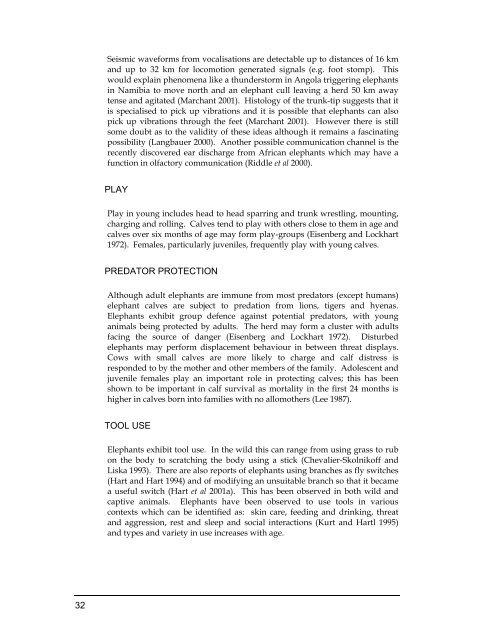Elephants Elephants - Wildpro - Twycross Zoo
Elephants Elephants - Wildpro - Twycross Zoo
Elephants Elephants - Wildpro - Twycross Zoo
Create successful ePaper yourself
Turn your PDF publications into a flip-book with our unique Google optimized e-Paper software.
32<br />
Seismic waveforms from vocalisations are detectable up to distances of 16 km<br />
and up to 32 km for locomotion generated signals (e.g. foot stomp). This<br />
would explain phenomena like a thunderstorm in Angola triggering elephants<br />
in Namibia to move north and an elephant cull leaving a herd 50 km away<br />
tense and agitated (Marchant 2001). Histology of the trunk-tip suggests that it<br />
is specialised to pick up vibrations and it is possible that elephants can also<br />
pick up vibrations through the feet (Marchant 2001). However there is still<br />
some doubt as to the validity of these ideas although it remains a fascinating<br />
possibility (Langbauer 2000). Another possible communication channel is the<br />
recently discovered ear discharge from African elephants which may have a<br />
function in olfactory communication (Riddle et al 2000).<br />
PLAY<br />
Play in young includes head to head sparring and trunk wrestling, mounting,<br />
charging and rolling. Calves tend to play with others close to them in age and<br />
calves over six months of age may form play-groups (Eisenberg and Lockhart<br />
1972). Females, particularly juveniles, frequently play with young calves.<br />
PREDATOR PROTECTION<br />
Although adult elephants are immune from most predators (except humans)<br />
elephant calves are subject to predation from lions, tigers and hyenas.<br />
<strong>Elephants</strong> exhibit group defence against potential predators, with young<br />
animals being protected by adults. The herd may form a cluster with adults<br />
facing the source of danger (Eisenberg and Lockhart 1972). Disturbed<br />
elephants may perform displacement behaviour in between threat displays.<br />
Cows with small calves are more likely to charge and calf distress is<br />
responded to by the mother and other members of the family. Adolescent and<br />
juvenile females play an important role in protecting calves; this has been<br />
shown to be important in calf survival as mortality in the first 24 months is<br />
higher in calves born into families with no allomothers (Lee 1987).<br />
TOOL USE<br />
<strong>Elephants</strong> exhibit tool use. In the wild this can range from using grass to rub<br />
on the body to scratching the body using a stick (Chevalier-Skolnikoff and<br />
Liska 1993). There are also reports of elephants using branches as fly switches<br />
(Hart and Hart 1994) and of modifying an unsuitable branch so that it became<br />
a useful switch (Hart et al 2001a). This has been observed in both wild and<br />
captive animals. <strong>Elephants</strong> have been observed to use tools in various<br />
contexts which can be identified as: skin care, feeding and drinking, threat<br />
and aggression, rest and sleep and social interactions (Kurt and Hartl 1995)<br />
and types and variety in use increases with age.

















